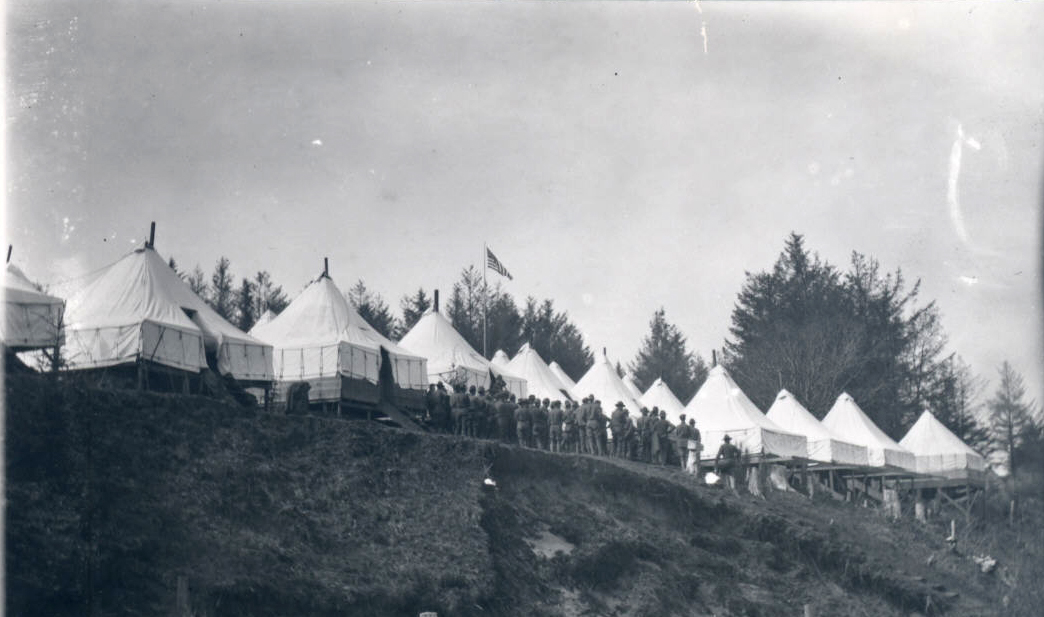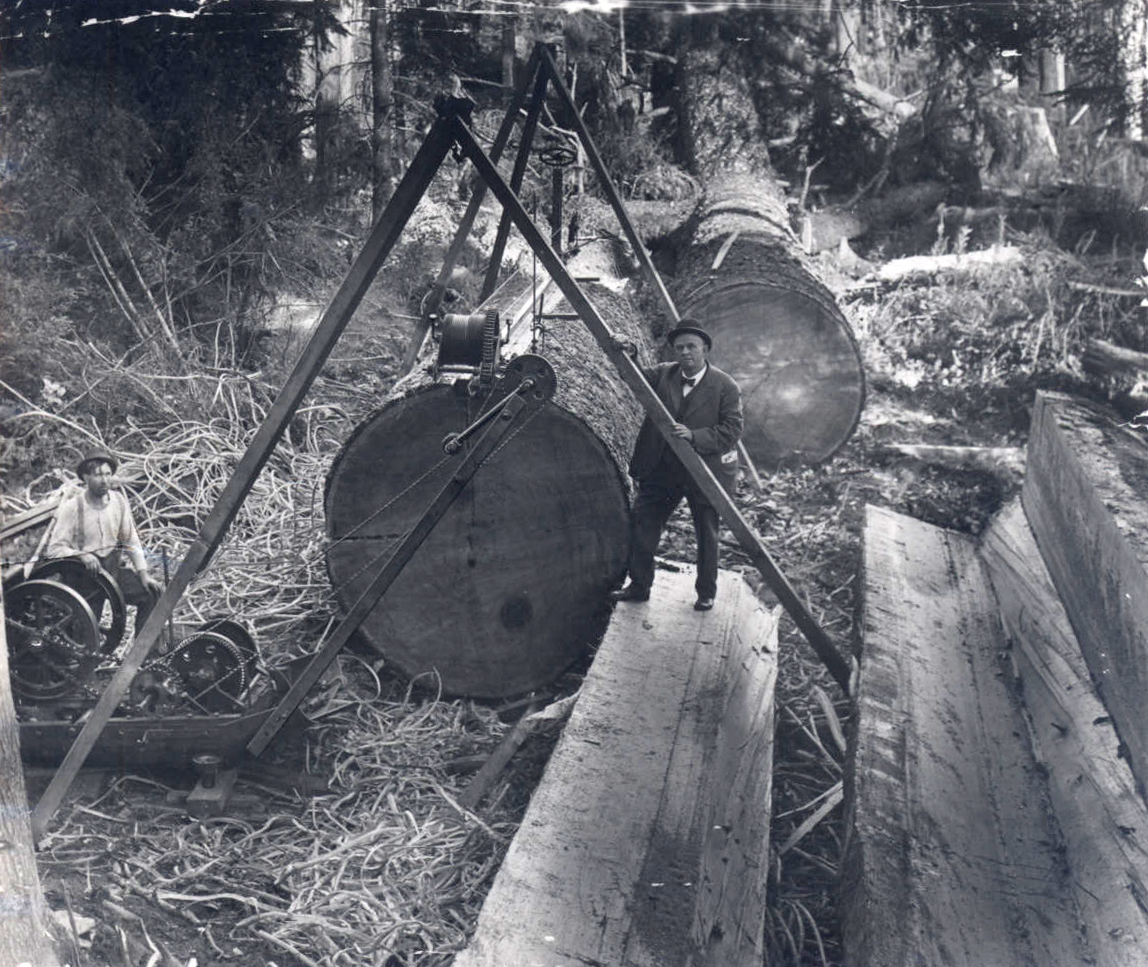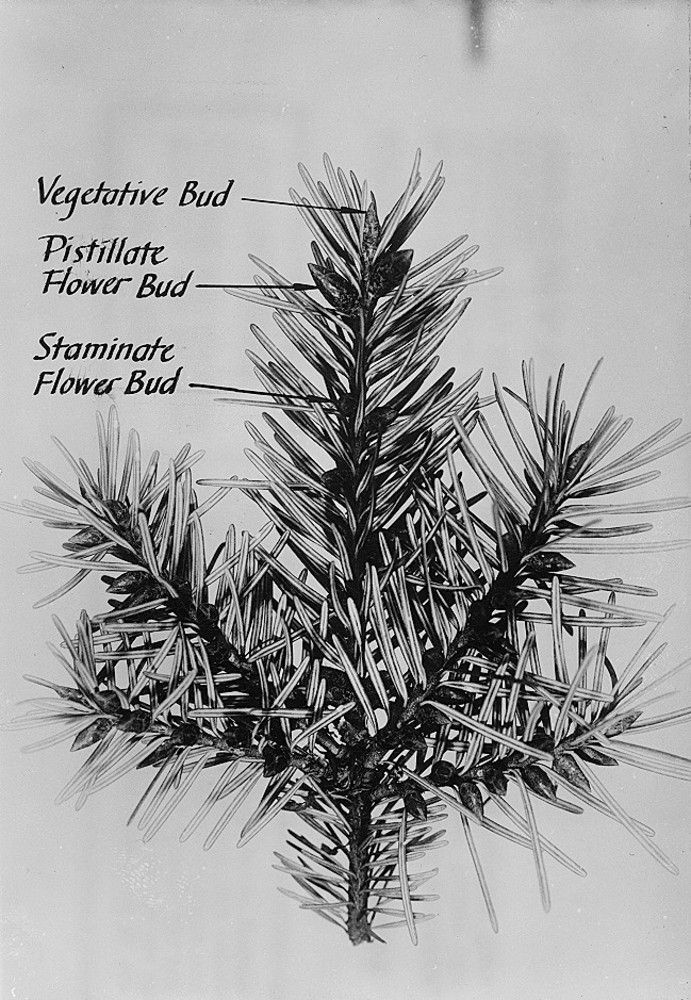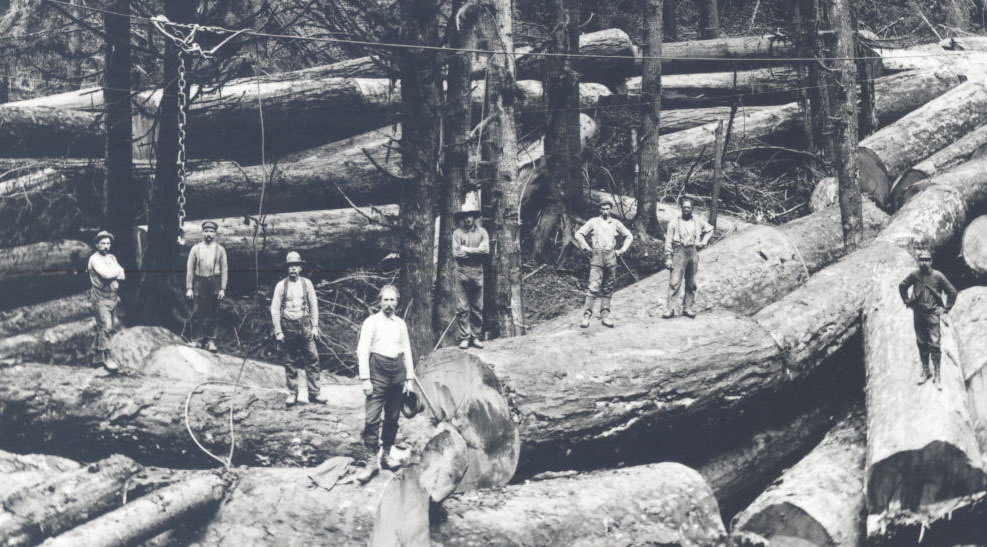In 1918, during World War I, almost thirty thousand U.S. soldiers were assigned to the Spruce Production Division (SPD) as part of the federal Loyal Legion of Loggers and Lumbermen (4L), a government-created union of loggers and sawmill owners formed to counteract widespread labor strikes by workers in the industry. The soldiers were charged with cutting Sitka spruce for airplanes and Douglas-fir for ships, protecting sawmills from sabotage, and fighting forest fires.
As early as 1916, the Pacific Northwest was the primary supplier of wood for aircraft frames to Great Britain, France, and Italy. The most important tree species for airplane construction was the Sitka spruce, a conifer that grew along the coastal rivers of northern California, Oregon, Washington, British Columbia, and Alaska. Sitka spruce, Brig. Gen. Brice P. Disque reported in 1919, “qualified better than any other wood in a combination of the necessary qualities of lightness, strength, resiliency, long and tough fibre and would not splinter when struck by a rifle bullet.”
On May 7, 1917, General Disque had been summoned to Washington, D.C., to study labor unrest in the Pacific Northwest. That summer, loggers and lumbermen who were members of the most powerful unions in the region—the Industrial Workers of the World and the American Federation of Labor—went on strike, halting much of the logging in regional forests. "Labor conditions were indescribably bad,” the official history of the Spruce Production Division reports. The striking workers wanted an eight-hour workday and better working and living conditions, historian Robert Tyler writes, including "sixty dollars a month…to be paid on two regular paydays per month….[bed]springs, mattresses, and bedding in all logging camps, showers and laundry rooms, hiring through union halls...free transportation to the job." The timber companies rejected the strikers’ demands.
To ensure that lumber would continue to be available for war-related industries, Disque recommended that the government station soldiers in the woods. To get the work done, the army established the 4L and managed it for a year before turning it over to civilian authorities.
General Disque wanted soldiers for the SPD who had experience working in the woods, but it soon became clear that there were not enough experienced men available. So the SPD began taking men who were physically fit but not eligible for the regular army, such as those who were illiterate. In all, more than a hundred thousand loggers and mill workers eventually joined the SPD to work in forests throughout the Pacific Northwest, including Idaho and western Montana.
Division headquarters was in the Yeon Building in downtown Portland; and Vancouver Barracks, on the Columbia River in Washington, was the main operational center for receiving, training, and disbursing the soldiers to regional forests and mills. More than 230 spruce soldier camps were located throughout the Pacific Northwest.
A number of private logging and sawmill owners requested that the soldiers be stationed at their camps and sawmills to help forestall another general strike and to decrease industrial sabotage and slowdowns. In addition to a number of smaller logging operations, the companies that requested soldiers included Grant, Smith-Porter Brothers in Clatsop County, Warren Spruce in Lincoln County, and the Airplane Lumber Company in Lincoln County.
While some soldiers worked in sawmill and logging operations, others were assigned to prevent sabotage and to counter non-4L union organizing efforts. Each camp had standard sleeping facilities, latrines, bathing and eating facilities, and recreation rooms, and soldiers worked a forty-hour workweek—conditions denied to striking workers in 1917. They were paid the same wage that loggers were paid, which protected the army from charges of strikebreaking. Many of the improvements in working conditions made during this time influenced the timber industry long after the SPD program ended.
There were no highways along the coast or over the Coast Range, and the Spruce Production Division proposed building railroads to serve isolated harvesting areas. The railroad construction program called for the completion of thirteen railroads in Washington and Oregon, with 173 miles of main line and 181 miles of tributary lines. Spruce railroad numbers 8 through 13 were built in Oregon: railroads 8 and 9 in Clatsop County, 10 through 12 in Lincoln County, and 13 in Coos County.
Over seventy-five hundred soldiers were assigned to three Oregon districts: Clatsop (3,342), Yaquina (3,370), and Coos Bay (870). Most of the men stationed at the nineteen SPD camps in Oregon worked in the forests to cut Sitka spruce and Douglas-fir, build railroad lines and bridges, and construct roads. In the summer of 1918, many SPD soldiers built roads that could transport the long spruce logs to sawmills at Yaquina in Oregon and at Port Angeles and Vancouver Barracks in Washington. During the fifteen months that the Spruce Production Division existed, solders contributed 53,718,591 board feet of high-quality aircraft-grade lumber (total production was 143,008,961 board feet).
With the end of World War I, on November 11, 1918, construction of the spruce railroads halted and SPD workers stopped felling trees. SPD soldiers were sent to Vancouver Barracks for discharge, and equipment and machinery were removed from logging sites for later sale. Equipment worth millions of dollars, some of it never used, was sold at auction in the fall of 1919 for pennies on the dollar, giving lumber companies such as C.D. Johnson a huge economic advantage over their competition and jump starting coastal logging operations with low-cost railroads, bridges, and new sawmill operations.
-
![Possibly Vancouver, Washington]()
Spruce Production Division camp, c.1918.
Possibly Vancouver, Washington Courtesy Oreg. Hist. Soc. Research Library, 017336
-
![Men are timed as they split spruce logs on the beach.]()
Members of the Spruce Division, Seaside.
Men are timed as they split spruce logs on the beach. Courtesy Oreg. Hist. Soc. Research Library, Oregonian collection, 009092
-
![Grant-Porters Brothers Company camp]()
Spruce Production Division camp, Clatsop County, 1918.
Grant-Porters Brothers Company camp Courtesy Oreg. Hist. Soc. Research Library, 010913
-
![]()
O.C. Tenlason with spruce riving machine, c.1918.
Courtesy Oreg. Hist. Soc. Research Library, Timberman Coll., 017399
Related Entries
-
![Douglas-fir]()
Douglas-fir
Douglas-fir (Pseudotsuga menziesii), perhaps the most common tree in Or…
-
![Sitka spruce]()
Sitka spruce
Sitka spruce (Picea sitchensis) is also known as the coast or tidewater…
-
![Timber Industry]()
Timber Industry
Since the 1880s, long before the mythical Paul Bunyan roamed the Northw…
Related Historical Records
Map This on the Oregon History WayFinder
The Oregon History Wayfinder is an interactive map that identifies significant places, people, and events in Oregon history.
Further Reading
Crossley, Rod. Soldiers in the Woods: The U.S. Army's Spruce Production Division in World War One. Portland, Ore.: Timber Times, 2014.
Disque, Brice P. "A Statement by Brice P. Disque, Late Brigadier General, U.S. Army," c.1919. Brice P. Disque Papers, Box 6, Special Collections, University of Oregon, Eugene.
History of Spruce Production Division, United States Army and United States Spruce Production Corporation. Portland, Ore.: Kilham Stationary & Printing Co., 1919.
Hyman, Harold M. Soldiers and Spruce: Origins of the Loyal Legion of Loggers and Lumbermen. Los Angeles: Institute of Industrial Relations, 1963
"In Fifteen Brief Months Spruce Production Division of the U.S. Army Springs from Nothing into a Tremendous War Winning Machine." Loyal Legion of Loggers and Lumbermen (December-January 1918-19).
Tonsfeldt, Ward A. The U.S. Army Spruce Production Division at Vancouver Barracks, Washington, 1917-1919. Vancouver, Wash.: National Park Service, 2013.
Tyler, Robert L. Rebels of the Woods: The I.W.W. in the Pacific Northwest. Eugene: University of Oregon Press, 1967
U.S. Army, Spruce Production Division, Special Orders, 1917-19. Carbon copies of the Spruce Production Division Special Orders are found in the Brice P. Disque Papers, Box 6, Special Collections, University of Oregon, Eugene.
Williams, Gerald W. “The Spruce Production Division.” Forest History Today (Spring 1999): 2-10.
Williams, Gerald W. and Gail E.H. Evans. "Over Here, Over Here: The Army's Spruce Production Division During 'The War to End All Wars'." In Military Influences on Washington History: Proceedings of a Conference, edited by William Woodward and David Hansen, 139-179. Tacoma: Washington National Guard, Camp Murray, 1984.







